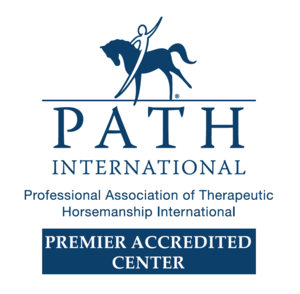Adaptive Riding is recreational horseback riding lessons for individuals with special needs. Riders learn horsemanship and riding skills in an environment tailored to their individual needs and learning styles. We offer instruction to riders of all skill levels, from providing someone's first contact with a horse to advanced independent riders. The goals for those in the adaptive riding program are riding-skill based, but individuals and parents often report many therapeutic benefits of participation. These benefits include improvements in physical strength, balance, coordination, mobility, self-confidence, self-control, peer interaction, and social skills.
Adaptive riding lessons are taught by PATH International certified instructors who create a wide variety of games and exercises designed to meet each student's needs. Lesson plans take into account the rider's physical, emotional, and mental strengths and limitations. Classes include arena riding, trail rides, and group activities. With the combination of a trusted horse, instructor, and group of volunteers, riders become more willing to try new things and attain new goals.
How Adaptive Riding Works
A horse's soothing rhythm, strength, warmth, and three-dimensional movement pattern provide healthy exercise while improving circulation and muscle tone. The discipline associated with working with horses and the social interactions between peers benefit the mind and spirit while raising self-esteem and increasing self-sufficiency through accomplishment. The unconditional love of the horses has been proved to reduce anxiety, encourage interaction, and offer a haven where riders can feel a sense of empowerment.
Who Benefits
Each week, approximately 174 children and adults with disabilities between the ages of 5 and 87 saddle up as a part of Little Bit’s adaptive riding program. These riders represent over 50 diagnoses and many have multiple diagnoses. Common diagnoses include, but are not limited to: autism, developmental delay or disability, ADD/ADHD, cerebral palsy, and down syndrome.






